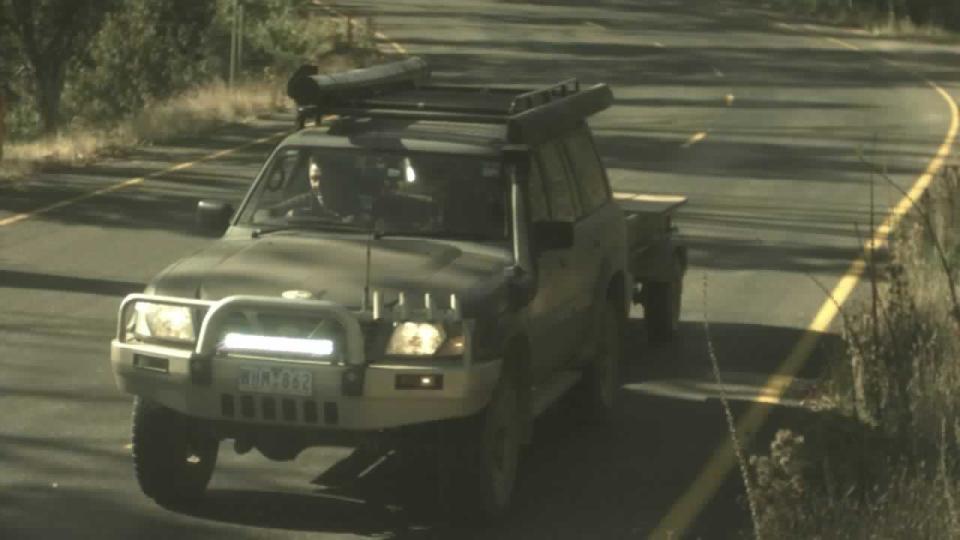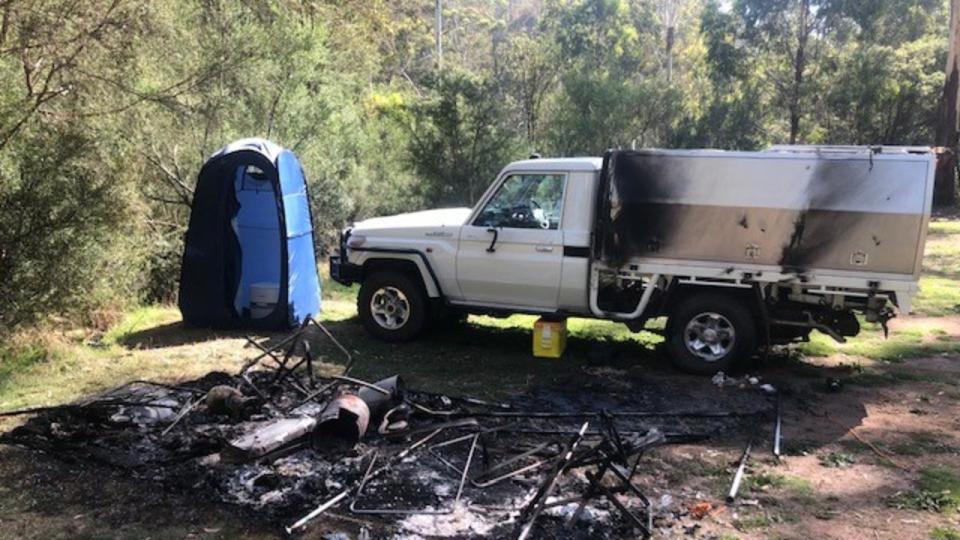Claim on alleged camper killer photo: court

The jury in the trial of accused double-murderer Greg Lynn has been told missing camper Russell Hill’s phone was tracked to the same road where the former pilot was inadvertently snapped by an automatic camera.
The 57-year-old former Jetstar captain is facing trial after pleading not guilty to the murders of Russell Hill, 74, and Carol Clay, 73, in Victoria’s High Country more than four years ago.
He returned before the Victorian Supreme Court on Monday, as the jury returned for the third week of evidence.

Prosecutors argue he killed the childhood sweethearts at the remote Bucks Camp on the evening of March 20, 2020, likely after a dispute with Mr Hill.
Through his lawyer, Mr Lynn is arguing the deaths were a tragic accident, set in motion after Mr Hill accused him of hunting too close to camp and stealing his gun.
At the start of the trial, the jury was told both parties accepted that Mr Lynn set fire to the pair’s campsite and dumped their bodies in bushland off the Union Spur track near Dargo.
Both parties also accepted that Mr Lynn returned in November the same year, where he set fire to their remains.
Phone ‘off the network’ for 46 hours
Telecommunications expert Dr Matthew Sorell told the jury he was asked by police to conduct analysis on data from four phones - belonging to Mr Lynn, Mr Hill and two belonging to Mrs Clay.
Using call and data records, he said he was able to estimate the location of the phones to within 78m by using their connections to various cell towers in a way “very similar to how radar works”.
Dr Sorell said the evidence suggested Mr Hill and Ms Clay left her home in Pakenham together in the morning of March 19, before arriving in the Alpine region about 12.30pm where service was lost.

The jury was told both of their phones did connect to the network the following day but Mr Hill’s reconnected briefly on March 21 at 9.24am.
Dr Sorell said over the following 26 minutes his opinion was Mr Hill’s phone travelled along the Dargo-High Plains Rd before turning on to the Great Alpine Rd, where the “last signalling records” occurred shortly after 9.50am.
“At some time after that, either the phone’s battery has gone flat or it has been damaged,” he said.
The jury was told this occurred close to where Mr Lynn was photographed driving through an automatic number plate recognition camera at 9.48am.
Dr Sorell said the records place Mr Hill’s phone “within 100m” of the Great Alpine Rd.

Dr Sorell said Mr Lynn’s phone had been tracked leaving his Caroline Springs home on March 16 and returning six days later.
About 2am on May 13, just hours after a snap lockdown had ended in Victoria, Mr Lynn’s phone was recorded heading back to the Alpine region, where it remained off the network between 5am and 12.48pm.
The jury was told Mr Lynn’s phone was also “off the network” for approximately 46 hours between November 18 and 20 the same year.
Under questioning from defence barrister Michael McGrath, Dr Sorell said this was consistent with Mr Lynn’s account to police following his arrest of returning to check on the bodies in May and burning the bodies in November.
Dr Sorell agreed there was “simply no way” of telling why a phone did not connect with the network.
Campers’ remains were ‘obliterated’
Called to give evidence, forensic pathologist Dr Melanie Archer told the jury more than 2000 bone fragments located in December 2021 were identified as the missing pair.
Questioned by prosecutor Kathryn Hamill, Dr Archer said it wasn’t possible to determined a cause of death.
“So the problem for the forensic pathologist was that the material needed has been obliterated by the change,” she said.
“Whatever has caused these deaths has been masked by this burning and fragmentation.”

The crown has argued his actions should be seen as an “implied admission” of guilt, while his barrister, Dermot Dann KC, said Mr Lynn made “terrible choices” fearing he would be wrongly blamed.
Dr Archer told the court Mr Hill and Mrs Clay’s remains were “too fragmented” to allow pathologists to make any findings.
Dr Archer was questioned about Mr Lynn’s account by Mr Dann, saying it was “consistent” with the available evidence.
“I’m not saying that's the only explanation, but its plausible and consistent with the evidence I see,” she said.
Insects suggest remains underwent decomposition before burning, jury told
Dr Archer, also a forensic entomologist, told the jury she was asked to look at insect samples taken from the Union Spur track near where the skeletal remains were found.
She said blow fly “puparia” — a hardened exoskeleton used as the insect transitions from maggot to fly — were found in the soil, suggesting the pair’s remains had decomposed prior to burning.
Blow flies, Dr Archer said, lay their offspring in human and animal remains as part of their life cycle.
She told the jury she was not able to provide an estimate of how long Mr Hill and Mrs Clay’s remains sat in the bush before they were later burned.

Prosecutors alleged Mr Hill was killed first by unknown means, and Mrs Clay was shot in the head soon after as a witness to the first slaying.
Last week, the jury was told cranial fragments linked by DNA to Mrs Clay were found at Bucks Camp.
But Mr Lynn, through his barrister, has asked the jury to accept his account of the deaths, saying Ms Clay was accidentally shot through the side mirror as the two men fought over a gun.
On his account Mr Hill then came at him with a knife screaming; “she’s dead”, and died by falling on the knife as the two men fought a second time.
The trial, before Justice Michael Croucher, continues.


